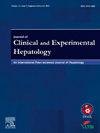Validation of Two Prognostic Gene Scores in Patients Undergoing Liver Resection for Hepatocellular Carcinoma
IF 3.3
Q2 GASTROENTEROLOGY & HEPATOLOGY
Journal of Clinical and Experimental Hepatology
Pub Date : 2025-03-11
DOI:10.1016/j.jceh.2025.102544
引用次数: 0
Abstract
Background/Aims
Several prognostic gene signatures have been proposed as predictors of the prognosis of hepatocellular carcinoma (HCC), yet none are implemented in the clinical setting. We aimed to validate two gene scores previously derived from European cohorts.
Methods
The patients who underwent liver resection for HCC at Copenhagen University Hospital, Rigshospitalet from 2014 to 2018 were included. RNA sequencing determined the expression of genes in the ‘5-gene score’ (HN1, RAN, RAMP3, KRT19, TAF9B) and ‘HepatoPredict’ (CLU, DPT, SPRY2, CAPSN1). Univariable Cox regression assessed associations with overall and disease-free survival. These parameters were also analyzed in the The Cancer Genome Atlas Liver Hepatocellular Carcinoma (TCGA-LIHC) (n = 359) and National Institute of Health (NIH) (n = 178) cohorts.
Results
Among 51 patients (88% male), 59% had no underlying liver disease and 25% had cirrhosis. No individual genes were significantly associated with overall survival in the Danish cohort. In the TCGA-LIHC cohort, CLU was linked to better overall survival, and in the NIH cohort, high expression of SPRY2 was associated with poorer overall survival. In the TCGA-LIHC cohort, HN1, RAN, and TAF9B were associated with poorer overall survival, while RAMP3 was linked to better overall survival. No genes were associated with disease-free survival.
Conclusion
Few individual genes significantly predicted survival in the larger cohorts, and none in the Danish cohort. However, the clinical implication of this needs further investigation.

肝细胞癌肝脏切除术患者两种预后基因评分的验证
背景/目的已有多个预后基因特征被提出作为肝细胞癌(HCC)预后的预测指标,但没有一个在临床环境中实施。我们旨在验证之前从欧洲队列中得出的两个基因评分。方法纳入了2014年至2018年在哥本哈根大学医院Rigshospitalet接受肝切除术的HCC患者。RNA测序确定了 "5基因评分"(HN1、RAN、RAMP3、KRT19、TAF9B)和 "HepatoPredict"(CLU、DPT、SPRY2、CAPSN1)中基因的表达。单变量 Cox 回归评估了总生存期和无病生存期的相关性。这些参数还在癌症基因组图谱肝肝细胞癌(TCGA-LIHC)(n = 359)和美国国立卫生研究院(NIH)(n = 178)队列中进行了分析。结果51名患者(88%为男性)中,59%没有潜在肝病,25%患有肝硬化。在丹麦队列中,没有单个基因与总存活率明显相关。在TCGA-LIHC队列中,CLU与较好的总生存率相关,而在NIH队列中,SPRY2的高表达与较差的总生存率相关。在TCGA-LIHC队列中,HN1、RAN和TAF9B与较差的总生存率有关,而RAMP3与较好的总生存率有关。结论在较大的队列中,很少有单个基因能显著预测生存期,而在丹麦队列中则没有。然而,这对临床的影响还需要进一步研究。
本文章由计算机程序翻译,如有差异,请以英文原文为准。
求助全文
约1分钟内获得全文
求助全文
来源期刊

Journal of Clinical and Experimental Hepatology
GASTROENTEROLOGY & HEPATOLOGY-
CiteScore
4.90
自引率
16.70%
发文量
537
审稿时长
64 days
 求助内容:
求助内容: 应助结果提醒方式:
应助结果提醒方式:


